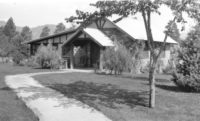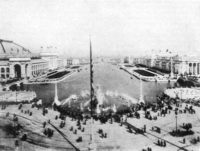Excerpt [pp. 427-429]
THE CITY BECOMES A LIVING MUSEUM
The rebuilding of the old Jewish Quarter would be guided by an advisory council of distinguished philosophers, historians, artists, architects, planners, theologians, and philanthropists called the Jerusalem Committee, established by the mayor immediately upon entering office. While several intrusive oversize modern buildings were constructed on the edge of the area, facing the Wailing Wall, inside the neighborhood a remarkable urban environment was constructed.
Retaining the architectural character of the quarter was a priority, so that the milieu of the greater historic city would not be disrupted. Initial surveys showed that about 50 percent of the sector's damaged historic structures could be rehabilitated. The other half would have to be built anew. In an area subject to earthquakes, proper foundations were a necessity-an extremely complicated procedure in old Jerusalem, which sits on the rubble and ruins accumulated over thousands of years of recurring destruction. Thus, a major portion of the site would first become a painstaking archaeological dig.
Several significant finds were made 20, 30, 40 feet below the surface: a wall from the first temple period of David and Solomon; remnants of a cluster of patrician dwellings from the period of Herod the Great; the architectural remains and furnishings of a Jewish house partially burned down during the Roman conquest of the city in A.D. 70; substantial elements of the Roman-Byzantine settlement; and parts of a Byzantine church constructed during the reign of the emperor Justinian.
In order to provide access to this material and to preserve it in place, it was decided to build the new houses of the Jewish Quarter on platforms suspended above the layers of history that until recently had been invisible. Aboveground, modern dwellings would be constructed of contextual design that knit together surviving fragments of the traditional vernacular townscape. Belowground, and sometimes open to the sky, the city would become a museum. As it had been for centuries, the old Jewish Quarter, with new and old courtyard houses, would continue as a place of secluded residential life, while also becoming an unrestricted civic space dedicated to public education. A three-dimensional network of passageways, stairs, and ramps connected the quarter's different parts.
Having taken two decades to accomplish, the final result is a startling redefinition of the function of the historic city. The modern housing, designed by a number of different architects and all made of Jerusalern stone, is intimate and various in its interpretation of multicultural building traditions. Winding medieval passageways open up to public plazas, where ancient remains are juxtaposed with the structures of contemporary life. From out of a large depression, decoratively carved capitals of the columns of the old Roman marketplace (the cardo) suddenly rise up into view. At their base, one sees the ground plane of the Roman era, which then extends beneath the city into subterranean spaces where the vaulted Byzantine emporium has been restored, with modern shops inserted into centuries-old archways.
Around the corner and up a flight of stone stairs, the visitor arrives at a later era of history: the remnants of the Byzantine Church of Saint Mary. Discreet informative labeling and signage abounds, informing the viewer in several languages of the interwoven incarnations of Jerusalem's past. Ruins of the great Hurvah Synagogue stand near a tall minaret of Mamluk configuration. In the underground space beneath a modern yeshiva, a museum of archaeology houses the exterior and interior remnants of Herodian mansions. The cool dim spaces offer respite from the sun. Time and the terrible differences that have divided Jerusalem for most of its history have been suspended.
Distinct architectural elements of different eras are melded together by the commonality of stone. In an era of continuing conflict, the essence of the Holy City has been reaffirmed: it is a place of unending search for self-knowledge. If ever the holiest city on earth achieves peace among its people, the restored Jewish Quarter provides a model for what the metropolis might become.






Post a comment to this article
Report Abusive Comment